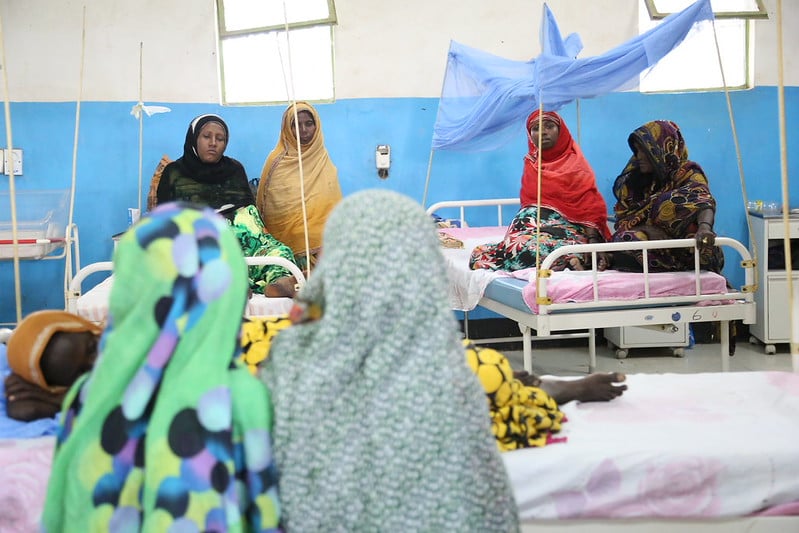Empowering the Future: Global Child Care Market Set to Surpass – openPR.com

Child Care Market Report: An Analysis of Growth, Trends, and Alignment with Sustainable Development Goals (SDGs)
Executive Summary
The global child care market was valued at USD 26.82 billion in 2023 and is projected to expand to USD 54.3 billion by 2035, demonstrating a compound annual growth rate (CAGR) of 6.05% from 2025 to 2035. This growth is intrinsically linked to progress on several United Nations Sustainable Development Goals (SDGs), particularly in the areas of quality education, gender equality, and economic growth. Key market drivers include increased female participation in the workforce, evolving family structures, and a heightened focus on early childhood education. The industry’s expansion reflects a global commitment to providing foundational support for children while enabling economic and social equity for parents.
Market Drivers and Contribution to Sustainable Development
SDG 5 & SDG 8: Empowering Gender Equality and Fueling Decent Work
A primary catalyst for the child care market’s expansion is the increasing participation of women in the global workforce. The availability of reliable child care is a critical enabler for gender equality (SDG 5), allowing women to pursue careers and contribute to household incomes. This trend, coupled with a rise in single-parent and dual-income households, directly supports the goal of achieving full and productive employment and decent work for all (SDG 8). Furthermore, employer-sponsored child care programs are emerging as a key corporate benefit, acknowledging the need to support working parents and foster a balanced, productive workforce.
SDG 4: Ensuring Quality Early Childhood Education
The market is experiencing a significant shift from basic custodial care to a focus on structured early childhood development. This aligns directly with SDG 4, which calls for ensuring inclusive and equitable quality education and promoting lifelong learning opportunities for all. The growing demand for preschools and educational programs emphasizes cognitive development, social skills, and school readiness, establishing a vital foundation for a child’s future learning journey.
SDG 10: Reducing Inequalities Through Accessible Care
Addressing the affordability and accessibility of child care is crucial for reducing societal inequalities (SDG 10). The market is diversifying its payment models to cater to various economic segments. Government-funded initiatives and non-profit assistance programs play a vital role in providing subsidized care for low-income families, ensuring that quality early childhood development is not limited to those with higher incomes. This multi-faceted approach helps bridge the gap and provides equitable opportunities for all children.
Market Segmentation Analysis
Service Type Segmentation
The market offers a diverse ecosystem of services tailored to different family needs, each contributing to child well-being (SDG 3) and educational development (SDG 4).
- Child Care Centers: The most prevalent option, valued for structured learning environments and regulated safety standards.
- Home-Based Care: A growing segment offering personalized care in a familiar setting, ideal for infants and toddlers.
- Nanny Services: A premium option providing flexible, one-on-one in-home care.
- Preschool Education: Increasingly integral for cognitive and social development in preparation for formal schooling.
- After School Programs: Provide safe and enriching environments for school-age children, supporting working parents.
Age Group Segmentation
Services are customized to meet the developmental milestones of different age groups, reinforcing the commitment to SDG 4.
- Infants (0-12 months): Require highly attentive and nurturing care.
- Toddlers (1-3 years): Demand for structured play and early educational activities.
- Preschoolers (3-5 years): Strong focus on school readiness and social skills.
- School-Age Children (6-12 years): Served by after-school programs and supplemental care.
Payment Model Segmentation
The diversification of funding models is key to enhancing accessibility and achieving SDG 10.
- Government Funded Programs: Broaden access to affordable services, particularly in North America and Europe.
- Private Pay Models: Dominate where state support is limited, often for premium services.
- Employer-Sponsored Child Care: A growing model that supports work-life balance and aligns with SDG 8.
- Non-Profit Assistance Programs: Crucial in supporting low-income families and reducing inequality.
Regional Outlook and Global Goal Alignment
The child care market exhibits distinct regional characteristics that reflect varying approaches to achieving development goals.
- North America: A mature market with strong regulatory frameworks and a rise in employer-sponsored programs, supporting SDG 5 and SDG 8. However, affordability remains a challenge to universal access.
- Europe: Characterized by strong government support and universal preschool, demonstrating a firm commitment to SDG 4 and SDG 10.
- Asia Pacific: Expected to witness the fastest growth due to urbanization, rising incomes, and a growing awareness of early childhood education, contributing significantly to regional economic growth (SDG 8).
- South America: Steady growth is driven by urban centers, with increasing involvement from the public sector and NGOs to improve accessibility.
- Middle East & Africa: A nascent market with rising demand for premium, international-standard services in urban areas.
Innovation, Technology, and Sustainability
The future of child care is being shaped by technological integration and a focus on sustainability. Mobile applications for parent-provider communication, AI-powered administrative tools, and virtual learning platforms are enhancing efficiency and engagement. Importantly, there is a growing emphasis on adopting environmentally friendly practices and constructing eco-friendly facilities, which aligns with the objectives of creating sustainable cities and communities (SDG 11).
Key Industry Stakeholders
The global child care market is shaped by numerous key organizations committed to providing quality care and education. Major companies include:
- Bright Horizons Family Solutions
- Children’s Learning Adventure
- Childcare Network
- Childtime Learning Centers
- Goddard Systems Inc
- Kindercare Education
- Kids ‘R’ Kids
- Learning Care Group
- Montessori Schools
- Primrose Schools
- Spring Education Group
- The Goddard School
- The Learning Experience
- Tutor Time Child Care
Analysis of Sustainable Development Goals in the Child Care Market Article
1. Which SDGs are addressed or connected to the issues highlighted in the article?
-
SDG 4: Quality Education
- The article extensively discusses the importance of early childhood education, preschools, and programs focused on cognitive development and school readiness. This directly aligns with the goal of ensuring inclusive and equitable quality education.
-
SDG 5: Gender Equality
- The article identifies “expanding female workforce participation” as a primary driver for the child care market. Access to reliable child care is a critical enabler for women to participate equally in the economy, thus connecting to the goal of achieving gender equality and empowering all women and girls.
-
SDG 8: Decent Work and Economic Growth
- The growth of the child care industry itself represents economic growth. Furthermore, the availability of child care services supports “dual-income” households and allows more parents, particularly women, to secure “full and productive employment,” which is a core aspect of SDG 8. The mention of “employer-sponsored child care” also links directly to creating better work environments.
-
SDG 10: Reduced Inequalities
- The article addresses the issue of affordability and access to child care by discussing various payment models. The inclusion of “Government Funded Programs” and “Non-Profit Assistance Programs” for “low-income families” highlights efforts to reduce inequalities in access to essential services like child care, which promotes social and economic inclusion.
2. What specific targets under those SDGs can be identified based on the article’s content?
-
Target 4.2: Ensure that all girls and boys have access to quality early childhood development, care and pre-primary education.
- The article’s focus on “Preschool Education” as a “vital foundation for lifelong learning” and the growing demand for services that promote “cognitive development, social interaction, and school readiness” directly correspond to this target.
-
Target 5.4: Recognize and value unpaid care and domestic work through the provision of public services, infrastructure and social protection policies.
- The entire child care market, as described, provides formal services that substitute for unpaid care work. The article mentions “government efforts” and “government-supported care,” which are forms of public services and social protection policies aimed at supporting families and enabling parents (often women) to join the workforce.
-
Target 8.5: Achieve full and productive employment and decent work for all women and men.
- The article states that the market is fueled by the “expanding female workforce” and the rise of “dual-income responsibilities.” The provision of child care is a key facilitator for parents to achieve full employment. Employer-sponsored child care is a specific mechanism mentioned that supports this target.
-
Target 10.2: Empower and promote the social, economic and political inclusion of all, irrespective of age, sex, disability, race, ethnicity, origin, religion or economic or other status.
- The discussion of “Government Funded Programs” and “Non-Profit Assistance Programs” aimed at making child care accessible to “low-income families” and single-parent households directly relates to promoting economic inclusion and ensuring that cost is not a barrier to accessing essential early childhood services.
3. Are there any indicators mentioned or implied in the article that can be used to measure progress towards the identified targets?
-
Indicators for Target 4.2:
- Participation rate in organized learning: The article implies this through its analysis of market demand for “Preschool Education” and “Child Care Centers” for the 3-5 year age group, noting their role in preparing children for school. The market share growth of these services is a proxy for this indicator.
-
Indicators for Target 5.4:
- Female workforce participation rate: The article explicitly states that “expanding female workforce participation” is a key driver of the market. An increase in this rate can be seen as an outcome of better child care availability.
- Availability of subsidized child care: The mention of “Government Funded Programs” and “Non-Profit Assistance Programs” implies that the number of available slots or the public/NGO expenditure on these programs can be used as an indicator.
-
Indicators for Target 8.5:
- Labor force participation rate by sex: The article’s emphasis on “working parents” and “dual-income” households suggests that the ability of both parents to work is a key outcome.
- Prevalence of employer-sponsored benefits: The growth of “Employer Sponsored Child Care” is a direct, measurable indicator of corporate contribution to this target.
-
Indicators for Target 10.2:
- Public expenditure on child care and early education: The article’s reference to “increasing public investments in early childhood education and care” in North America and Europe points to government spending as a key metric for ensuring broad access.
- Proportion of low-income families receiving child care support: This is implied by the discussion of “Non-Profit Assistance Programs” and government funding aimed at making services affordable for these families.
4. Summary Table of SDGs, Targets, and Indicators
| SDGs | Targets | Indicators (Mentioned or Implied in the Article) |
|---|---|---|
| SDG 4: Quality Education | 4.2: By 2030, ensure that all girls and boys have access to quality early childhood development, care and pre-primary education. |
|
| SDG 5: Gender Equality | 5.4: Recognize and value unpaid care and domestic work through the provision of public services and social protection policies. |
|
| SDG 8: Decent Work and Economic Growth | 8.5: By 2030, achieve full and productive employment and decent work for all women and men. |
|
| SDG 10: Reduced Inequalities | 10.2: By 2030, empower and promote the social, economic and political inclusion of all, irrespective of economic or other status. |
|
Source: openpr.com

What is Your Reaction?
 Like
0
Like
0
 Dislike
0
Dislike
0
 Love
0
Love
0
 Funny
0
Funny
0
 Angry
0
Angry
0
 Sad
0
Sad
0
 Wow
0
Wow
0




































![Lancaster homeowner’s energy-efficient renovation sparks clash over historic preservation [Lancaster Watchdog] – LancasterOnline](https://bloximages.newyork1.vip.townnews.com/lancasteronline.com/content/tncms/assets/v3/editorial/9/ed/9ed03d32-c902-44d2-a461-78ad888eec38/69050b156baeb.image.png?resize=150,75#)











































